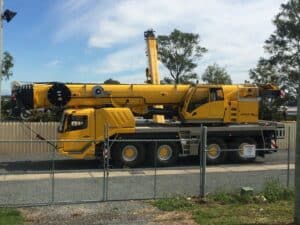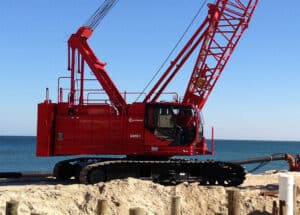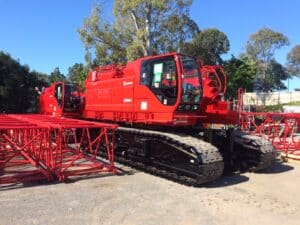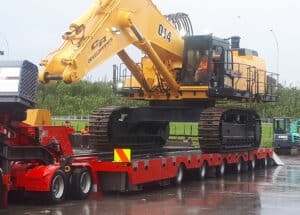Looking Into The Future Of Battery-Powered Cranes

Why battery electric cranes?
The increasing costs of emission controls and regulation for diesel-powered equipment make the case for switching to electric lifting undeniable for companies looking to replace older cranes.
The market for used cranes for sale is still thriving, despite the introduction of new battery-powered cranes in the industry.
With thermal power being replaced by electric power in all other commercial and consumer sectors, the level of usage of diesel-powered machines is expected to decrease in the next 10 to 15 years.
Therefore, it is important for companies to carefully assess the trends and risks associated with diesel-powered equipment before making a decision.
There is an argument that battery cell systems are more long-lasting and cost-effective than even the most advanced carbon fuel power systems. As more research is done into battery-powered equipment, we are finding electric cranes can meet the demands of the modern world with some ease, with longer charge cycles and faster battery charging systems.
New AC electrics and solid-state systems also help reduce battery power requirements. crane users are understanding that we have to adapt, discarding old ideas. Electric power is long-lasting, eliminates workplace health risks with zero emissions, and supports a low-noise working environment. Battery electric cranes are safer and simpler to operate, which makes them a preferred choice for a growing number of lifting professionals as well.
The benefits of battery-powered cranes
Electric or battery-powered cranes offer many benefits over traditional diesel engine-powered cranes. One of the most significant advantages is that electric cranes generate no emissions, which is not only better for the environment but also for the operator and those working nearby. Electric cranes are also much quieter than their diesel counterparts, which can be a major benefit in noise-sensitive work environments.
Another key advantage of electric cranes is that they require less maintenance than diesel-powered cranes. Electric motors have far fewer moving parts than internal combustion engines, meaning there are fewer opportunities for something to go wrong. When something does go wrong with an electric motor, it is often easier and less expensive to fix than a diesel engine.
Electric cranes also tend to be more energy-efficient than diesel-powered cranes. Electric motors are more efficient at converting energy into motion, meaning that less energy is wasted in the form of heat. This can lead to significant cost savings over the lifetime of an electric crane.
Finally, electric cranes offer greater safety than their diesel-powered counterparts. Electric cranes are less likely to catch fire, and the risk of explosions is significantly lower. This is due to the fact that electric cranes do not use flammable fuels such as diesel or gasoline.
If you are in the market for a new crane, an electric or battery-powered crane is an excellent option to consider. These cranes offer numerous benefits over traditional diesel-powered cranes, including lower emissions, less noise, less maintenance, greater energy efficiency, and improved safety.
The challenges of battery-powered cranes
As the construction industry increasingly turns to electric-powered machines to help reduce environmental impact, one of the key challenges facing equipment manufacturers is how to provide the power needed to operate larger, more demanding equipment such as cranes.
While the market for electric-powered construction equipment is growing, the lack of available charging infrastructure remains a challenge. In many cases, construction sites are not able to provide the necessary power to recharge batteries, meaning that electric machines must be used for shorter periods of time or must be plugged into the grid, which can be expensive.
Another challenge facing manufacturers of electric construction equipment is the development of battery technology. Current battery technology is not able to provide the power needed to operate large construction machines for extended periods of time. This means that electric construction machines are often only used for small tasks or for short periods of time.
Despite the challenges, the market for electric construction equipment is expected to grow in the coming years. As battery technology improves and charging infrastructure becomes more available, electric construction equipment will become more widely used, providing a cleaner and more sustainable option for the construction industry.
The potential for new battery technology to improve the power and performance of cranes
The development of new battery technology has the potential to revolutionize the power and performance of cranes. While the current battery technology used in cranes is adequate for most applications, it is not without its drawbacks. New battery technology has the potential to improve upon the current technology in a number of ways, resulting in increased power and performance for cranes.
The first way that new battery technology could improve the power and performance of cranes is by increasing the capacity of the batteries. Current battery technology is limited in the amount of power that it can store, which ultimately limits the amount of work that a crane can do. New battery technology has the potential to increase the capacity of batteries, allowing cranes to store more power and work for longer periods of time.
In addition to increasing the capacity of batteries, new battery technology also has the potential to improve the efficiency with which they store and release energy. Current battery technology is not always very efficient, meaning that a lot of the power that is stored in the batteries is lost during the discharge process. New battery technology has the potential to be much more efficient, meaning that more of the power stored in the batteries can be used to power the crane.
Finally, new battery technology also has the potential to improve the safety of cranes. Current battery technology can be dangerous, as the batteries can leak chemicals or catch fire if they are not properly cared for. New battery technology has the potential to be much safer, as it is less likely to leak chemicals or catch fire.
Is battery power really more environmentally friendly?
It turns out that the answer is a bit complicated. If you’re only considering the emissions from the electric crane or other electric tools itself, then yes, battery-powered models are almost always better for the environment. But if you take into account the emissions from the power plant that supplies electricity to charge the battery, the picture is less clear.
The most important factor in determining the environmental friendliness of a battery-powered tool is the type of battery it uses. Lead-acid batteries, which are commonly used in car batteries, are more environmentally friendly. Lithium-ion batteries, often the type of battery used to power cranes, are not as friendly.
The emissions from charging a lithium-ion battery depending on the type of power plant that supplies the electricity. If the power plant uses coal, the emissions from charging the battery will be higher than if the power plant uses natural gas.
On top of that, there are the emissions created when mining for the minerals to manufacture these batteries, the manufacturing process itself creates emissions and the disposal of used batteries is not exactly environmentally friendly.
Conclusion
Whilst the idea of having battery-powered cranes as a suitable replacement for diesel-powered cranes sounds good from an environmental perspective. This is not really the case as of right now.
We are headed in the right direction as the crane industry, amongst others, that are reliant on fossil fuels, are researching more into renewable electric energy sources.





